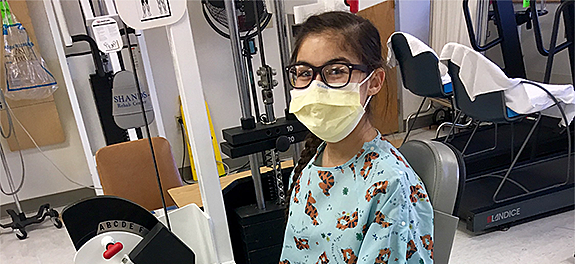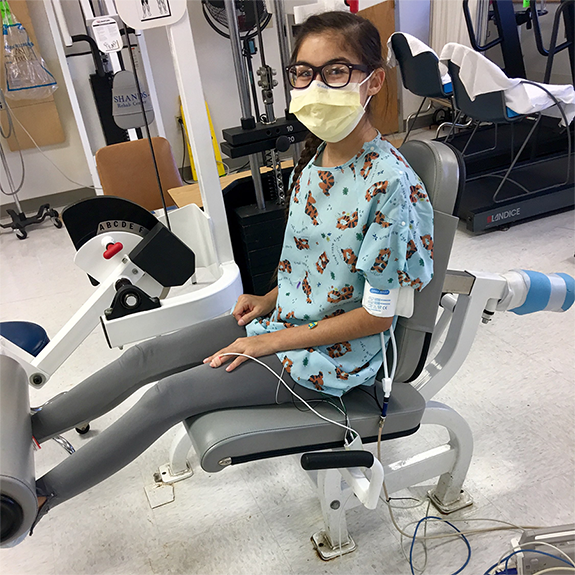Nayla’s New Lungs

For as long as she can remember, Nayla Rivera and her father, Chris, have trekked from one medical appointment to another, mostly in South Florida.
When she was 6 months old, Nayla vomited on a regular basis. Initially, doctors diagnosed her with acid reflux. To rule out anything more serious, Nayla was sent to have a sweat test, a procedure that confirms cystic fibrosis, or CF, a life-threatening lung disorder.
The results came back positive.
“I started reading about CF, and found there was no cure,” Chris said.
Growing up, Nayla never let her CF diagnosis interfere with her desires to play soccer or cheerlead.
“She’s loyal. She’s cool. She’s very strong,” Chris said.

Like clockwork, Nayla would be admitted to a hospital each December for a ‘’tune-up,’’ a procedure that cleans out the lungs for CF patients. Tune-ups often require a three- to six-week stay, sometimes interfering with holidays including Christmas and New Year’s Day.
When Nayla was 13, Chris began to notice she became winded much faster than before. He also noticed that his daughter caught colds frequently and remained sick for weeks.
Three years later, Nayla’s condition took a turn for the worse as her lung capacity dwindled. “The doctors weren’t sure if she would make it,” Chris said.
With few options left and the need for tune-ups becoming more frequent, Nayla’s physician recommended that she travel to UF Health Shands Children’s Hospital in Gainesville to discuss a lung transplant. The hospital is the only one in Florida that has a pediatric lung transplant program. It is also among a handful in the country to utilize a technique called cadaveric lobar transplantation, which allows the thoracic surgeon to downsize lungs from an adult donor and transplant them into smaller pediatric recipients. This capability leads results in significantly shorter wait times for pediatric lung transplant candidates and avoids deaths on the waitlist.
In July 2017, Chris and Nayla met Michael Tsifansky, M.D., a pediatric intensivist and pulmonologist and the medical director for the UF Health Pediatric Lung Transplant program. At the appointment, Nayla was so sick, that she had to be hospitalized for another tune-up while Tsifansky and his team assessed to see if she would be a candidate for transplantation.
The process and preparation for becoming a lung transplant recipient are rigorous. Steps to get on the list include showing adequate physical strength, good nutritional status and emotional determination. While patients need to be sick enough to need a transplant, they also need to be well enough to heal afterward.
In December, Nayla had her third tune-up of the year and, on the 29th, she was approved at UF Health to be added to the transplant list. Nayla was now sent home to wait for her lungs to arrive.
She didn’t have to wait long.
“On Jan. 4, I was coming home from work and I got the call,” Chris said. “We’ve got the lungs.”
Nayla and Chris rushed to a nearby hospital where they took an ambulance to the airport and flew to Gainesville. In the meantime, physicians in Gainesville were assessing the lungs to ensure they were the best match.
“Nayla was freaky calm,’’ Chris said.
When they got to Gainesville, Nayla was admitted to the hospital for the 10-hour surgery performed by Tiago Machucha, M.D., Ph.D., a thoracic surgeon and the surgical director of the UF Health Pediatric Lung Transplant Program. Machuca and his team utilized cadaveric lobar transplantion technique, which allowed Nayla to get a successful transplant only several days after listing.
“You see him in scrubs, but the way that he treated me wasn’t like (he was) a doctor,” Chris said. “It was like we knew each other. He made sure I understood what he was telling me.”
Nayla received her new lungs on Jan. 5 and started on the long road to recovery. Each day, Nayla had to relearn everyday actions like walking, washing her hair and brushing her teeth.
Chris remained by his daughter’s bedside and drew strength from the support provided by the hospital staff. “The whole team is awesome,” Chris said.
“Every one of them brings something different to the table.”
Chris offered advice to other parents going through a similar situation.
“It’s going to be lonely, and no one is going to really know what you’re going through. They can sympathize, but no one’s really going to be able to relate,” Chris said. “There are going to be times you get frustrated and want to give up. You’ve got to be mentally strong and never show that you’re afraid. We [parents] are like their superheroes.’’
In February, Nayla was discharged to live in transplant housing before going back to South Florida in March. Nayla and Chris left for home, knowing her physicians were only a phone call away.
“This is the first time I’ve had doctors’ and nurses’ cell numbers,’’ Chris said. “Not because I asked them for it. That’s amazing. There’s only so much acting a person can do. They don’t have to give these numbers out.”
One month after being home, doctors noticed subtle signs of possible rejection, a term used when the body does not want to completely accept the new organ. As a safety precaution, Nayla returned to Gainesville for a treatment that would rid the body of the antibodies against the new lungs and the cells that produced them. The procedure was a resounding success.
Now, with her new set of lungs, Nayla can focus on just being a 16-year-old. She’d like to become a doctor or researcher. To help others like herself.
About the author
